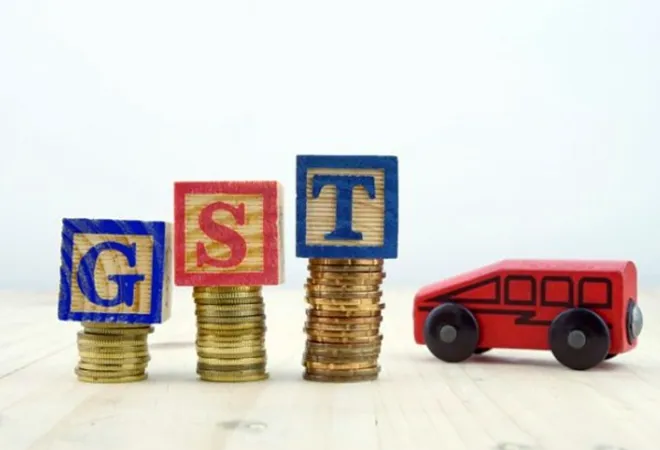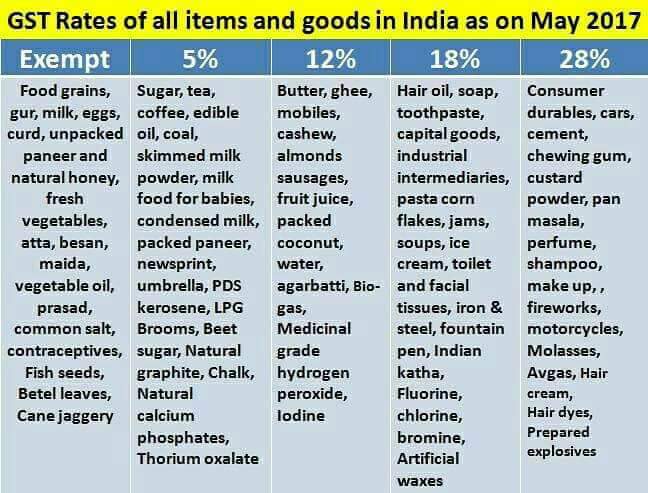-
CENTRES
Progammes & Centres
Location
India’s biggest fiscal and federal reform since independence will begin its maiden race at the stroke of midnight on 1 July with implementation of the GST.

At the stroke of midnight on 1 July, the goods and services tax (GST) will begin its maiden race. Arguably India’s biggest fiscal and federal reform since Independence, this piece of legislation and the accompanying rates, rules and regulations drafted by the GST Council has several weights it needs to carry to the finishing line. To reach the start line itself was a long struggle. But going forward, the race is going to get steeper. The GST is expected to reduce frictions as goods are transported across India, increase GDP growth, bring ease to doing business and raise the country rankings, map India’s tax system to best indirect tax practices across 122 jurisdictions across the world, all the while keeping prices of essentials unchanged, and the inflation under control. While debates on the efficacy and efficiency of the way GST is rolled out will begin from G-Day, we need to keep one thing in mind.
GST is a marathon, not a 100-metre dash.
Read also | Impact of GST on doing business will show up in 2019 rankings
In the history of Independent India, the only other mega economic reform that gets anywhere close to the impact that the GST potentially will have is Prime Minister P.V. Narasimha Rao’s opening of the doors of the Indian economy in 1991. Much of the middle India economic prosperity we see today is the result of this brave step taken by Rao and his Finance Minister Manmohan Singh, 25 years ago. Likewise, the GST is an economic marathon, whose impact will be felt over the next quarter of a century. When the economy opened up to foreign investors in 1991, the Bombay Club closed ranks to protest the end of protected markets. Arguments for delaying economic reforms and liberalisation included the need for a level playing field and an allowance to achieve scale before allowing foreign firms in. As the economy opened up, sector by sector, to Indian as well as foreign capital and entrepreneurs, we saw resistance from entrenched players. From steel and cement to telecom and retail, every player used every trick in the book to hold back a reform that was irreversible.
Today, the highways we drive on, the metros that carry us in comfort, the world’s lowest call charges we pay, the variety of consumer goods in our homes and so on, are all part of this marathon — behind every product and service is this overarching directional reform. What the Rao-Singh duo did was unleash a process.
https://twitter.com/sureshpprabhu/status/879650218312179712
It is a similar process that Prime Minister Narendra Modi, Finance Minister Arun Jaitley and all State finance ministers are unleashing today. The GST is a system that balances four operational objectives. One, it is expected to keep the tax revenues of the Union and State governments constant in the short term and grow them over the medium to long term. Two, it expects to capture every transaction in the economy, above a threshold turnover, digitally and track its economic journey from production to consumption, manufacturer or service provider to distributor to retailer to consumer. Three, because of the system of input credits, where an entity paying taxes can reduce the taxes already paid on the good or service, and therefore the incentive to, and importance of, being in the GST network it expects to increase the number of taxpayers, and through them the taxes collected. And four, because the cascading of taxes is reduced, the overall prices in the economy and through them the inflation rate are expected to remain the same or reduce. It is through these four objectives, arrived at through a complex negotiation of finance ministers at the Centre and the States, and through them taking the politics as well as the economics into account, that the other benefits of GST, including the ease of doing business and rise in GDP growth, will express themselves.
Read also| The world is cheering India’s GST, but we need to remain on high alert
https://twitter.com/abhijitmajumder/status/880670864374730753
While the GST is expected to remove fiscal barriers to trade, and speed up the velocity of transactions, goods and services, and money through it, it is going to be a long haul. Each sector will have its specific problems, each geography of producers and consumers its unique challenges. The fact that the entire system is digital in a country where neither electricity nor wifi are as ubiquitous as the system expects them to be will pose reporting hurdles: look beyond the metros and State capitals, and see why businesses there are seeing the GST system with fear and apprehension. Now, add the twin jurisdictions — tax bureaucracies at the Central and the States — that an entity needs to report its revenues and pay taxes to and you know why businesses are not distributing sweets yet.
The fact that two of the States’ largest tax revenue generators, alcohol and fuels, have been kept out of the GST for now is yet another instance of a political inefficiency being embedded into an economic system. These, we hope, will get sorted out sooner rather than later.
Read also | Success or failure? 5 indicators to evaluate GST performance
Like the long-distance runner who approaches the 26-mile, 385-yard marathon needs to have a different approach from one who is looking at a 100-metre dash, in the economic policy space too we need to be able to differentiate between short-term fixes and long-term strategies. The Reserve Bank of India (RBI) accepting misselling by commercial banks and aiming to fix it through regulations is a short-term fix — a tiny change in stance that will bring relief to millions of consumers. For RBI to clean up the non-performing assets of banks is a medium-term policy. Having begun now, it will play out over the next three to five years. But for Parliament to pass the Indian Financial Code and realign financial regulators, including the RBI, is a long-term strategy. It will take years for it to get implemented and bring decades of benefits. The GST system, like the economic reforms of 1991, is one that will take at least four quarters to stabilise, until which it will remain a work in progress, and after which most of the administrative as well as technical glitches will be overcome. But its benefits will carry on for decades.

What can we expect in the short term? Here’s a shortlist of five forecasts.
One, the first two quarters will bring a huge compliance pressure on hundreds of thousands of tiny, small, and medium-sized businesses, not only in the structure and rates of GST but in its administration and compliance. GDP growth will slow down. There will be protests and uproars across the country that will be politicised. These will be based on anecdotes and will take a long time to turn into data. We hope that the government, unlike its insecure and confrontational response to demonetisation, will behave in a more mature manner and be in a listening mode rather than squelch criticism through denial or by attributing motives. It is heartening to see the government begin with a more facilitative stance than its immature combative bearings — from free software offerings to assuaging fears about the number of returns to be filed, revenue secretary Hasmukh Adhia is out there giving comfort. So, is Finance Minister Arun Jaitley. These steps must continue.
Two, errors of omission as well as commission will creep up. While the former can be fixed, Commerce Minister Nirmala Sitharaman has assured businesses that here would be no penalty for non-filing of returns for small and medium businessmen for three months. This is a good enough starting point. That said, here’s a sample of warnings raised by the RBI on the latter: non-registration by small businesses, under-reporting by traders, reduction of tax liability by exaggerating the proportion of taxes in lower slabs, collecting but not remitting tax to the government, and making false claims for refunds. Expect the GDP growth to slow down in the first two quarters of this transition.
Three, by the third quarter, most businesses will realise that the GST is not only irreversible but a more efficient system and will begin to learn and adjust. They will be helped by the GST Suvidha Providers. Six months is enough time for governments to see the folly of leaving businesses vulnerable to tax bureaucrats, excessive compliance and even outsourcing compliance to businesses in some cases. Due to this needless complexity, the process of GST could become larger than its purpose. With the voices of businesses now large enough to be turned into data, expect that in one of its future meetings, the GST Council will change some procedures, iron out anomalies, even restructure rates.
Four, by the fourth quarter, benefits of the GST system will begin to show up — faster movement of goods, paying taxes digitally and efficiency of input credits, that will ease doing business and increase India’s rankings. Remember, GST is not merely a new way of paying taxes or new rates on which to pay them; the benefits of a friction-free and transparent way of doing business will outweigh the costs of transition. That said, expect new litigation to come up, though it won’t be very different from what is being seen today.
And five, after the initial shock of seeing how much they are paying, by the fourth quarter, consumers will psychologically adjust to seeing the GST paid on every good they buy and every service they use. At the retail level, there still could be some glitches but in the aggregate things should smoothen out. The government has assured that prices will remain stable or fall. The next 12 months should see this theoretical projection turn into reality. If the government makes good its promise of keeping the inflation rate under control, households too would embrace the GST.
https://twitter.com/DDNewsLive/status/880614893954531328
Read also | GST rates: How many is too many?
Nobody, not even the government, is arguing that the GST is a perfect system of indirect taxes. But we can’t let good be the enemy of perfect. It is a work in progress and has the flexibility to be nimble-footed, a trait we hope the GST Council will display over the next four quarters. And 25 years later, our children will look back from a more prosperous India and write about the bitter pill that we, their parents, swallowed today for a better tomorrow.
Let the GST marathon begin.
The views expressed above belong to the author(s). ORF research and analyses now available on Telegram! Click here to access our curated content — blogs, longforms and interviews.

Gautam Chikermane is Vice President at Observer Research Foundation, New Delhi. His areas of research are grand strategy, economics, and foreign policy. He speaks to ...
Read More +